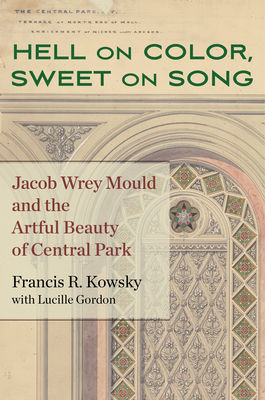
Hell on Color, Sweet on Song: Jacob Wrey Mould and the Artful Beauty of Central Park
Description
WINNER, VICTORIAN SOCIETY IN AMERICA BOOK AWARD
WINNER, 2024 PUBLICATION PRIZE, FRIENDS OF THE UPPER EAST SIDE HISTORIC DISTRICTS
Reveals new and previously unknown biographical material about an important figure in nineteenth-century American architecture and music.
Jacob Wrey Mould is not a name that readily comes to mind when we think of New York City archi-tecture. Yet he was one-third of the party responsible for the early development of the city's Central Park. To this day, his sculptural reliefs, tile work, and structures in the Park enthrall visitors. Mould introduced High Victorian architecture to NYC, his fingerprint most pronounced in his striking and colorful ornamental designs and beautiful embellishments found in the carved decorations and mosaics at the Bethesda Terrace. Resurfacing the forgotten contributions of Mould, Hell on Color, Sweet on Song presents a study of this nineteenth-century American architect and musical genius.
Jacob Wrey Mould, whose personal history included a tie to Africa, was born in London in 1825 and trained there as an architect before moving to New York in 1852. The following year, he received the commission to design All Souls Unitarian Church. Nicknamed "the Church of the Holy Zebra," it was the first building in America to display the mix of colorful materials and medieval Italian inspira-tion that was characteristic of High Victorian Gothic architecture. In addition to being an architect and designer, Mould was an accomplished musician and prolific translator of opera librettos. Yet anxiety over money and resentment over lack of appreciation of his talents soured Mould's spirit. Unsystematic, impractical, and immune from maturity, he displayed a singular indifference to the realities of architecture as a commercial enterprise. Despite his personal shortcomings, he influenced the design of some of NYC's revered landmarks, including Sheepfold, the Metropolitan Museum of Art, the American Museum of Natural History, the City Hall Park fountain, and the Morningside Park promenade. From 1875 to 1879, he worked for Henry Meiggs, the "Yankee Pizarro," in Lima, Peru.
Resting on the foundation of Central Park docent Lucille Gordon's heroic efforts to raise from obscurity one of the geniuses of American architecture and a significant contributor to the world of music in his time, Hell on Color, Sweet on Song sheds new light on a forgotten genius of American architecture and music.
Funding for this book was provided by: Furthermore: a program of the J. M. Kaplan Fund
